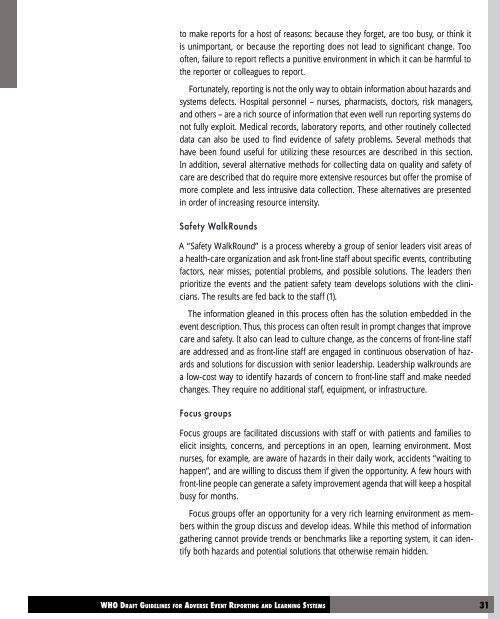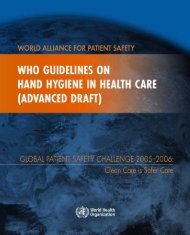Adverse event reporting.pdf
Adverse event reporting.pdf
Adverse event reporting.pdf
You also want an ePaper? Increase the reach of your titles
YUMPU automatically turns print PDFs into web optimized ePapers that Google loves.
to make reports for a host of reasons: because they forget, are too busy, or think it<br />
is unimportant, or because the <strong>reporting</strong> does not lead to significant change. Too<br />
often, failure to report reflects a punitive environment in which it can be harmful to<br />
the reporter or colleagues to report.<br />
Fortunately, <strong>reporting</strong> is not the only way to obtain information about hazards and<br />
systems defects. Hospital personnel – nurses, pharmacists, doctors, risk managers,<br />
and others – are a rich source of information that even well run <strong>reporting</strong> systems do<br />
not fully exploit. Medical records, laboratory reports, and other routinely collected<br />
data can also be used to find evidence of safety problems. Several methods that<br />
have been found useful for utilizing these resources are described in this section.<br />
In addition, several alternative methods for collecting data on quality and safety of<br />
care are described that do require more extensive resources but offer the promise of<br />
more complete and less intrusive data collection. These alternatives are presented<br />
in order of increasing resource intensity.<br />
Safety WalkRounds<br />
A “Safety WalkRound” is a process whereby a group of senior leaders visit areas of<br />
a health-care organization and ask front-line staff about specific <strong>event</strong>s, contributing<br />
factors, near misses, potential problems, and possible solutions. The leaders then<br />
prioritize the <strong>event</strong>s and the patient safety team develops solutions with the clinicians.<br />
The results are fed back to the staff (1).<br />
The information gleaned in this process often has the solution embedded in the<br />
<strong>event</strong> description. Thus, this process can often result in prompt changes that improve<br />
care and safety. It also can lead to culture change, as the concerns of front-line staff<br />
are addressed and as front-line staff are engaged in continuous observation of hazards<br />
and solutions for discussion with senior leadership. Leadership walkrounds are<br />
a low-cost way to identify hazards of concern to front-line staff and make needed<br />
changes. They require no additional staff, equipment, or infrastructure.<br />
Focus groups<br />
Focus groups are facilitated discussions with staff or with patients and families to<br />
elicit insights, concerns, and perceptions in an open, learning environment. Most<br />
nurses, for example, are aware of hazards in their daily work, accidents “waiting to<br />
happen”, and are willing to discuss them if given the opportunity. A few hours with<br />
front-line people can generate a safety improvement agenda that will keep a hospital<br />
busy for months.<br />
Focus groups offer an opportunity for a very rich learning environment as members<br />
within the group discuss and develop ideas. While this method of information<br />
gathering cannot provide trends or benchmarks like a <strong>reporting</strong> system, it can identify<br />
both hazards and potential solutions that otherwise remain hidden.
















